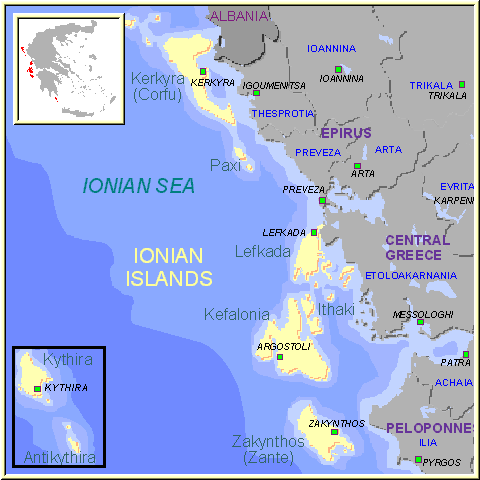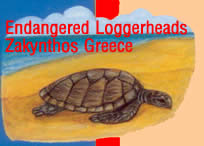 The islands in the Ionian group to the west of the Greek mainland are far greener than most of the Aegean islands, due to heavy rains between October to March.
The islands in the Ionian group to the west of the Greek mainland are far greener than most of the Aegean islands, due to heavy rains between October to March.
Kerkyra (Corfu) is by far the greenest, but also the most heavily dominated by package tourism, with Zakynthos (also called Zante) following close behind.
The strong Venetian influence in the architecture of the capital cities of these islands is another general characteristic. Kerkyra is best visited in the off season to avoid the crowds, though one can find some out of the way beaches even in peak season; spring is spectacular for its wildflower display, with 43 kinds of orchids.
Paxi, the smallest island in the group, though it lacks sandy beaches, has a stunning harbor capital off bounds to cars (though tourist crowds get thick in season), lovely countryside and villages, and olive groves which produce prize winning olive oil, the trees not sprayed for insect control, but protected through ecological sticky traps). Paxi has small coves for swimming, and popular with yacht owners, though possibly the most expensive island in the Ionian group.
Lefkadha can be driven onto from the mainland, though not the nicest way to go, as its northeast corner is very built up. Away from there , the island has high mountains, traditional villages, vineyards, olive groves, forests of pine and fir, ten islets, crowded beches on the east coast and remote, uncrowded ones on the west. Music and dance are popular in the villages, and an international festival held on the island.
Kefalonia, the second largest island in the Ionian group, has high mountains and very rugged terrain, with a national park established to protect the remaining indigenous fir forest, the fertile region of Livatho, and many sandy beaches. The devastating earthquake of 1953 wiped out most of its Venetian buildings, but the reconstruction of the harbor was done tastefully.
Ithaki (known in English as Ithaca) is drier and rockier than the others (except for Kythira) but it has some cypress, pine and olive trees, sites associated with Homeric accounts of Odysseus, mountains, fishing villages, coves to swim in, monasteries and churches. Like Paxi, it's a good walking island, for escaping the crowds, even in peak season, and for seeing some authentic Greek life.
Zakynthos (Zante the Venetian name), is green and fertile on the southern and eastern coasts, with its best beaches in those areas, with a fertile plain in the island's center and a barren and mountainous northwest.
 Endangered loggerhead turtle nesting sites on its southern beaches have been heavily impacted by unchecked tourist activity.
Endangered loggerhead turtle nesting sites on its southern beaches have been heavily impacted by unchecked tourist activity.
Saints' day festivals with traditional music and dance (paneyiria, in Greek), are frequent events on Ithaki.
Kythira is far from the other Ionian islands, way down off the southern tip of the Peloponisos (Peloponnese), and has a dry, scrubby landscape (with a few arable exceptions). Its 40 some-odd villages with flat roofed, white washed houses, resemble Cycladic architecture more than Ionian. A quiet place for most of the year, from mid-July to mid-September its large emigrant Greek population visits from Australia and Athens, but the villages have adequate rooms to absorb the overflow from the bigger towns. Good beaches with very clear water are among Kythira's attractions. The rocky little island of Antikythira is 30 km to the south of Kythira, with a beach and taverna, an often windy place visited by those seeking isolation.
Also see Eco islands of the Ionian: Corfu, Zakynthos, Cephalonia, Paxoi.